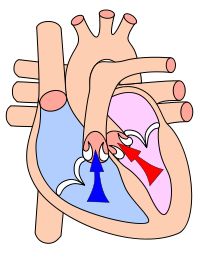
Photo from wikipedia
Right ventricular (RV) functional adaptation to afterload determines outcome in pulmonary hypertension (PH). RV afterload is determined by the dynamic interaction between pulmonary vascular resistance (PVR), characteristic impedance (Zc) and… Click to show full abstract
Right ventricular (RV) functional adaptation to afterload determines outcome in pulmonary hypertension (PH). RV afterload is determined by the dynamic interaction between pulmonary vascular resistance (PVR), characteristic impedance (Zc) and wave reflection. Zc and wave reflection can be estimated from RV pressure waveform analysis and cardiac output. Estimations of Zc and wave reflection coefficient (l) were validated relative to conventional spectral analysis in an animal model. Zc, l, and single beat ratio of end-systolic to arterial elastance (Ees/Ea) to estimate RV-pulmonary arterial (PA) coupling were determined from right heart catheterization (RHC) data. The study included 30 pulmonary artery hypertension (PAH) and 40 heart failure with preserved ejection fraction (HFpEF) patients (20 combined pre- and post-capillary PH; Cpc-PH and 20 isolated post-capillary PH; Ipc-PH). Also included were 10 age and sex-matched controls. There was good agreement with minimal bias between estimated and spectral analysis-derived Zc and l. Zc in PAH and Cpc-PH exceeded that in Ipc-PH and controls. l was increased in Ipc-PH (0.84±0.02), Cpc-PH (0.87±0.05), and PAH (0.85±0.04) compared to controls (0.79±0.03), all p-value<0.05. l was the only afterload parameter associated with RV-PA coupling in PAH. In PH-HFpEF, RV-PA uncoupling was independent of RV afterload. Our findings indicate that Zc and l derived from RV pressure curve, can be used to improve estimation of RV afterload. l is the only afterload measure associated with RV-PA uncoupling in PAH while RV-PA uncoupling in PH-HFpEF appears to be independent of afterload consistent with an inherent abnormality of the RV myocardium.
Journal Title: Journal of applied physiology
Year Published: 2021
Link to full text (if available)
Share on Social Media: Sign Up to like & get
recommendations!